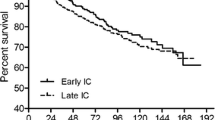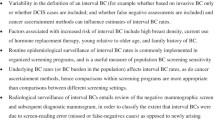Abstract
In the context of a population-based screening program, we aimed to evaluate the major mammographic features and clinicopathological characteristics of breast tumors at diagnosis and the associations between them, focusing on tumors with the worst prognosis. We analyzed cancers diagnosed in a cohort of 645,764 women aged 45–69 years participating in seven population-based screening programs in Spain, between January 1, 2000 and December 31, 2006 and followed up until June 2009. We included all interval cancers and a sample of screen-detected cancers, whether invasive or in situ. We compared tumor-related information and breast density for different phenotypes (Triple-negative (TN), HER2+, Luminal B and Luminal A) in screen-detected and interval cancers. We used Chi-square or Fisher’s exact test to compare major mammographic features of invasive versus in situ tumors, of screen-detected versus interval cancers, and of different types of interval cancers. We included 2582 tumors (1570 screen-detected and 1012 interval cancers). There were significant differences in the distribution of most clinicopathological variables between screen-detected and interval cancers. Invasive TN interval tumors were more common than other phenotypes in breasts with low mammographic density; three-quarters of these tumors presented as masses without associated calcifications. HER2+ tumors were more common in denser breasts and were associated with calcifications and multifocality. Architectural distortion was more common in Luminal A and Luminal B tumors. Certain radiologic findings are associated with pre-invasive lesions; these differ among invasive tumor phenotypes. We corroborate that TN and HER2+ cancers have distinctive appearances also in the context of population-based screening programs. This information can be useful for establishing protocols for diagnostic strategies in screening units.


Similar content being viewed by others
References
Tabar L, Tony Chen HH, Amy Yen MF, Tot T, Tung TH, Chen LS, Chiu YH, Duffy SW, Smith RA (2004) Mammographic tumor features can predict long-term outcomes reliably in women with 1–14-mm invasive breast carcinoma. Cancer 101(8):1745–1759
Sartor H, Borgquist S, Hartman L, Olsson A, Jawdat F, Zackrisson S (2015) Do mammographic tumor features in breast cancer relate to breast density and invasiveness, tumor size, and axillary lymph node involvement? Acta Radiol 56(5):536–544
Eroles P, Bosch A, Pérez-Fidalgo JA, Lluch A (2012) Molecular biology in breast cancer: intrinsic subtypes and signaling pathways. Cancer Treat Rev 38(6):698–707
Elias SG, Adams A, Wisner DJ, Esserman LJ, van’t Veer LJ, Mali WP, Gilhuijs KG, Hylton NM (2014) Imaging features of HER2 overexpression in breast cancer: a systematic review and meta-analysis. Cancer Epidemiol Biomark Prev 23(8):1464–1483
Sun SS, Zhang B, Zhao HM, Cao XC (2014) Association between mammographic features and clinicopathological characteristics in invasive ductal carcinoma of breast cancer. Mol Clin Oncol 2(4):623–629
Gao B, Zhang H, Zhang SD, Cheng XY, Zheng SM, Sun YH, Zhang DW, Jiang Y, Tian JW (2014) Mammographic and clinicopathological features of triple-negative breast cancer. Br J Radiol 87(1039):20130496
Krizmanich-Conniff KM, Paramagul C, Patterson SK, Helvie MA, Roubidoux MA, Myles JD, Jiang K, Sabel M (2012) Triple receptor-negative breast cancer: imaging and clinical characteristics. AJR Am J Roentgenol 199(2):458–464
Ko ES, Lee BH, Kim HA, Noh WC, Kim MS, Lee SA (2010) Triple-negative breast cancer: correlation between imaging and pathological findings. Eur Radiol 20(5):1111–1117
Wang Y, Ikeda DM, Narasimhan B, Longacre TA, Bleicher RJ, Pal S, Jackman RJ, Jeffrey SS (2008) Estrogen receptor-negative invasive breast cancer: imaging features of tumors with and without human epidermal growth factor receptor type 2 overexpression. Radiology 246(2):367–375
Yang WT, Dryden M, Broglio K, Gilcrease M, Dawood S, Dempsey PJ, Valero V, Hortobagyi G, Atchley D, Arun B (2008) Mammographic features of triple receptor-negative primary breast cancers in young premenopausal women. Breast Cancer Res Treat 111(3):405–410
Domingo L, Salas D, Zubizarreta R, Baré M, Sarriugarte G, Barata T, Ibáñez J, Blanch J, Puig-Vives M, Fernández A, Castells X, Sala M, INCA Study Group (2014) Tumor phenotype and breast density in distinct categories of interval cancer: results of population-based mammography screening in Spain. Breast Cancer Res 16(1):R3
Perry N, Broeders M, de Wolf C, Törnberg C, Holland R, von Karsa L (2006) European guidelines for quality assurance in breast cancer screening and diagnosis, 4th edn. Office for Official Publications of the European Communities, Luxembourg
Boyd NF, Byng JW, Jong RA, Fishell EK, Little LE, Miller AB, Lockwood GA, Tritchler DL, Yaffe MJ (1995) Quantitative classification of mammographic densities and breast cancer risk: results from the Canadian National Breast Screening Study. J Natl Cancer Inst 87(9):670–675
Hammond ME, Hayes DF, Dowsett M, Allred DC, Hagerty KL, Badve S, Fitzgibbons PL, Francis G, Goldstein NS, Hayes M, Hicks DG, Lester S, Love R, Mangu PB, McShane L, Miller K, Osborne CK, Paik S, Perlmutter J, Rhodes A, Sasano H, Schwartz JN, Sweep FC, Taube S, Torlakovic EE, Valenstein P, Viale G, Visscher D, Wheeler T, Williams RB, Wittliff JL, Wolff AC, American Society of Clinical Oncology, College of American Pathologists (2010) American Society of Clinical Oncology/College of American Pathologists guideline recommendations for immunohistochemical testing of estrogen and progesterone receptors in breast cancer (unabridged version). Arch Pathol Lab Med 134(7):e48–e72
Wolff AC, Hammond ME, Schwartz JN, Hagerty KL, Allred DC, Cote RJ, Dowsett M, Fitzgibbons PL, Hanna WM, Langer A, McShane LM, Paik S, Pegram MD, Perez EA, Press MF, Rhodes A, Sturgeon C, Taube SE, Tubbs R, Vance GH, van de Vijver M, Wheeler TM, Hayes DF, American Society of Clinical Oncology/College of American Pathologists (2007) American Society of Clinical Oncology/College of American Pathologists guideline recommendations for human epidermal growth factor receptor 2 testing in breast cancer. Arch Pathol Lab Med 131(1):18–43
Elston CW, Ellis IO (1991) Pathological prognostic factors in breast cancer. I. The value of histological grade in breast cancer: experience from a large study with long-term follow-up. Histopathology 19(5):403–410
Goldhirsch A, Wood WC, Coates AS, Gelber RD, Thürlimann B, Senn HJ, Panel members (2011) Strategies for subtypes–dealing with the diversity of breast cancer: highlights of the St. Gallen International Expert Consensus on the Primary Therapy of Early Breast Cancer 2011. Ann Oncol 22(8):1736–1747
Ildefonso C, Vazquez J, Guinea O, Perez A, Fernandez A, Corte MD, Junquera S, Gonzalez LO, Pravia P, Garcia-Moran M, Vizoso FJ (2008) The mammographic appearance of breast carcinomas of invasive ductal type: relationship with clinicopathological parameters, biological features and prognosis. Eur J Obstet Gynecol Reprod Biol 136(2):224–231
Brouckaert O, Schoneveld A, Truyers C, Kellen E, Van Ongeval C, Vergote I, Moerman P, Floris G, Wildiers H, Christiaens MR, Van Limbergen E, Neven P, MBC Leuven, Belgium (2013) Breast cancer phenotype, nodal status and palpability may be useful in the detection of overdiagnosed screening-detected breast cancers. Ann Oncol 24(7):1847–1852
Holm J, Humphreys K, Li J, Ploner A, Cheddad A, Eriksson M, Törnberg S, Hall P, Czene K (2015) Risk factors and tumor characteristics of interval cancers by mammographic density. J Clin Oncol 33(9):1030–1037
Kurbel S (2013) In search of triple-negative DCIS: tumor-type dependent model of breast cancer progression from DCIS to the invasive cancer. Tumour Biol 34(1):1–7
Vera-Badillo FE, Napoleone M, Ocana A, Templeton AJ, Seruga B, Al-Mubarak M, AlHashem H, Tannock IF, Amir E (2014) Effect of multifocality and multicentricity on outcome in early stage breast cancer: a systematic review and meta-analysis. Breast Cancer Res Treat 146(2):235–244
Tamimi RM, Baer HJ, Marotti J, Galan M, Galaburda L, Fu Y, Deitz AC, Connolly JL, Schnitt SJ, Colditz GA, Collins LC (2008) Comparison of molecular phenotypes of ductal carcinoma in situ and invasive breast cancer. Breast Cancer Res 10(4):R67
Gajdos C, Tartter PI, Bleiweiss IJ, Hermann G, de Csepel J, Estabrook A, Rademaker AW (2002) Mammographic appearance of nonpalpable breast cancer reflects pathologic characteristics. Ann Surg 235(2):246–251
Esposito A, Criscitiello C, Curigliano G (2015) Highlights from the 14(th) St Gallen International Breast Cancer Conference 2015 in Vienna: dealing with classification, prognostication, and prediction refinement to personalize the treatment of patients with early breast cancer. E Cancer Med Sci 9:518
Acknowledgments
This work was supported by Instituto de Salud Carlos III-FEDER (PI 09/01153, PI09/02385, PI09/01340).
Author information
Authors and Affiliations
Corresponding author
Ethics declarations
Conflict of interest
The authors declare that they have no conflict of interest.
Additional information
On behalf of INCA Study Group. The members of INCA Study Group are given in Appendix.
Appendix: INCA study group
Appendix: INCA study group
The authors acknowledge the dedication and support of the entire Interval Cancer (INCA) Study Group. The members of the Interval Cancer (INCA) Study Group are (alphabetical order): IMIM (Hospital del Mar Medical Research Institute), Barcelona: Jordi Blanch, Xavier Castells, Mercè Comas, Laia Domingo, Francesc Macià, Juan Martínez, Ana Rodríguez-Arana, Marta Román, Anabel Romero, Maria Sala. General Directorate Public Health and Centre for Public Health Research (CSISP), FISABIO, Valencia: Carmen Alberich, María Casals, Josefa Ibáñez, Amparo Lluch, Inmaculada Martínez, Josefa Miranda, Javier Morales, Dolores Salas, Ana Torrella. Galician Breast Cancer Screening Programme, Xunta de Galicia: Raquel Almazán, Miguel Conde, Montserrat Corujo, Ana Belén Fernández, Joaquín Mosquera, Alicia Sarandeses, Manuel Vázquez, Raquel Zubizarreta. General Directorate of Health Care Programmes. Canary Islands Health Service: Teresa Barata, Isabel Díez de la Lastra, Juana María Reyes. Basque Country Breast Cancer Screening Programme, Osakidetza: Arantza Otegi, Garbiñe Sarriugarte. Corporació Sanitària Parc Taulí, Sabadell: Marisa Baré, Núria Torà. Hospital Santa Caterina, Girona: Joana Ferrer, Francesc Castanyer, Gemma Renart. Epidemiology Unit and Girona Cancer Registry; and University of Girona: Rafael Marcos-Gragera, Montserrat Puig-Vives. Biomedical Research Institut of Lleida (IRBLLEIDA): Carles Forné, Montserrat Martínez-Alonso, Albert Roso, Montse Rué, Ester Vilaprinyó . Universitat Rovira i Virgili, Tarragona: Misericordia Carles, Aleix Gregori, María José Pérez, Roger Pla.
Rights and permissions
About this article
Cite this article
Baré, M., Torà, N., Salas, D. et al. Mammographic and clinical characteristics of different phenotypes of screen-detected and interval breast cancers in a nationwide screening program. Breast Cancer Res Treat 154, 403–415 (2015). https://doi.org/10.1007/s10549-015-3623-9
Received:
Accepted:
Published:
Issue Date:
DOI: https://doi.org/10.1007/s10549-015-3623-9




